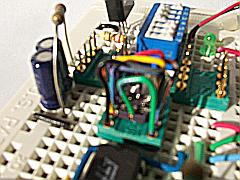Years ago–probably about 2000, shortly after I got my first Handspring PDA–I saw an article on adding a solid-state tilt sensor to your Palm computer. I was enchanted by the idea of playing games by tilting the PDA from side to side, but even more excited about the possibilities for walking, balancing robots.
After reading about Analog Devices’ ADXL202, a micro-machined +/- 2g accelerometer with pulse-width modulated (PWM) digital output, I filled out their sample request form and received two chips in the mail. Unfortunately, I ordered the LCC (brick with leads painted onto the surface) instead of the small-form-factor surface-mount chip, thinking I’d find an LCC socket for it. Alas, I never did locate one.
I had long thought I should make some kind of daughterboard for the chip, with DIP pins on the underside to make it easier to use for prototyping. Fast-forward to 2005. After I was no longer commuting to Pittsburg, I had much greater continuity of free time between weekday evenings and weekends. I also had all my spare junk in one place. ![]() I desoldered a larger LCC socket from a scrap board and cut opposing corners out of it with a razor saw, thinking I might be able to glom something together that would work, but to no avail.
I desoldered a larger LCC socket from a scrap board and cut opposing corners out of it with a razor saw, thinking I might be able to glom something together that would work, but to no avail.
Finally, late last fall, I did what any self-respecting (or was that desperate?) tinkerer would do: I soldered leads to the chip and stuck them into the top side of a machined DIP socket. It’s gross. It’s tacky. It’s done and it works.

The machined pins on the DIP socket fit very nicely into another DIP socket, and it works perfectly on my solderless breadboard. After assembling the carrier, I added the supporting components and a power supply, and was at last able to confirm that the device worked! I hooked it up to my scope and tilted it back and forth, enthralled by the tidy constant-period waveform with the high region changing width as I moved the board. W00T!